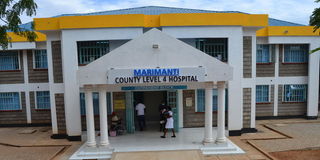Tharaka elders warn against consumption of killer wild honey

Marimanti Level Four Hospital in Tharaka constituency in Tharaka Nithi County where most of victims of poisonous wild honey are treated.
Ameru’s Njuri Ncheke council of elders has warned against the consumption of the Tharaka community's most sought-after wild honey which has killed 11 people and left scores fighting for their lives in hospitals in the last two years.
‘Nchuura’, as it is locally known by the Tharaka people, is not made by the common bees; it is produced by a species of smaller bees known as ‘tuchuura’ that do not sting and mainly make the honey in hollow trees or abandoned holes on the ground.
Speaking to the media in Marimanti town on Wednesday led by the council’s national vice-chairman Alphonse Kamwara, the elders who are the custodians of the Ameru community’s culture which include consumption of traditional foods have declared the wild honey dangerous to the people.
In contrast, the Tharaka people have for ages known the honey, which is eaten raw to be medicinal, curing illnesses and improving immunity.
The honey is mainly harvested by loggers or herders out in the fields because the special bees live in cool places away from any disturbance.
“We are calling upon our people to stop consuming the honey because it is no longer medicinal as it used to be but (is) poison,” said Mr Kamwara.
He said the honey has killed many people, especially children leaving the residents in great pain.
A few hours after consuming, the victims of the poisonous honey become weak and start vomiting and diarrheaing while complaining of stomach pains.
If not treated urgently, victims die in a few hours.
Food poisoning
Once rushed to the hospital, the victims are treated for food poisoning and most of those who start medication early enough recover and are discharged within one week.
Mr Kamwara said unless the government proves otherwise through analysis of the samples of the killer honey, the locals should keep off the delicacy.
A survivor of the killer honey, Mr James Muthengi from Kiamaara village in Karocho location in Tharaka South Sub-County told the Nation that he took only half a glass and in less than three hours he fell sick.
“I was given the honey by a neighbour who had found it in a hollow tree in a nearby stream and in less than three hours I started experiencing stomach pains, vomiting and diarrhearing. I was rushed to Kibunga Sub-County Hospital and later transferred to Marimanti Level Four Hospital where I was admitted for a week,” said Mr Muthengi.
He said three people died and 11 were successfully treated at Marimanti Sub-County Hospital.
Two weeks ago, a Standard Eight boy from Tumbura area in Kathuura Sub-Location, Tharaka South Sub-County died while another one was successfully treated at Marimanti Level Four Hospital after they reportedly consumed the poisonous honey.
Turima chief Philip Mutugi said an elderly man who had reportedly harvested the honey and helped the two boys on was also treated at Kibunga Sub-County Hospital.
In August last year, two children died and 19 adults from Rukaani village in Tharaka North Sub-County were treated in the same health facility after reportedly consuming the poisonous honey which had been harvested by loggers.
In the previous month, two people from Kiaruni village in Tharaka South Sub-County also died while eight others were treated at the same hospital after consuming the honey.
In July 2021, three people from Muguruka village in Turima location died and four others were treated at the same hospital.
Common honey
The incident came just a day after a seven-year-old boy in Gichiini village in Tharaka North Sub-County had died and four others were successfully treated at a hospital in Mukothima after consuming the common honey made by bees.
In the previous month, two family members from Riamikui village the same sub-county had died and another was successfully treated at Meru Teaching and Referral Hospital after reportedly consuming poisonous honey.
A report from Marimanti Level IV Hospital indicated that there was no dangerous chemical in the three samples of the honey which were taken to the government laboratory for analysis.





